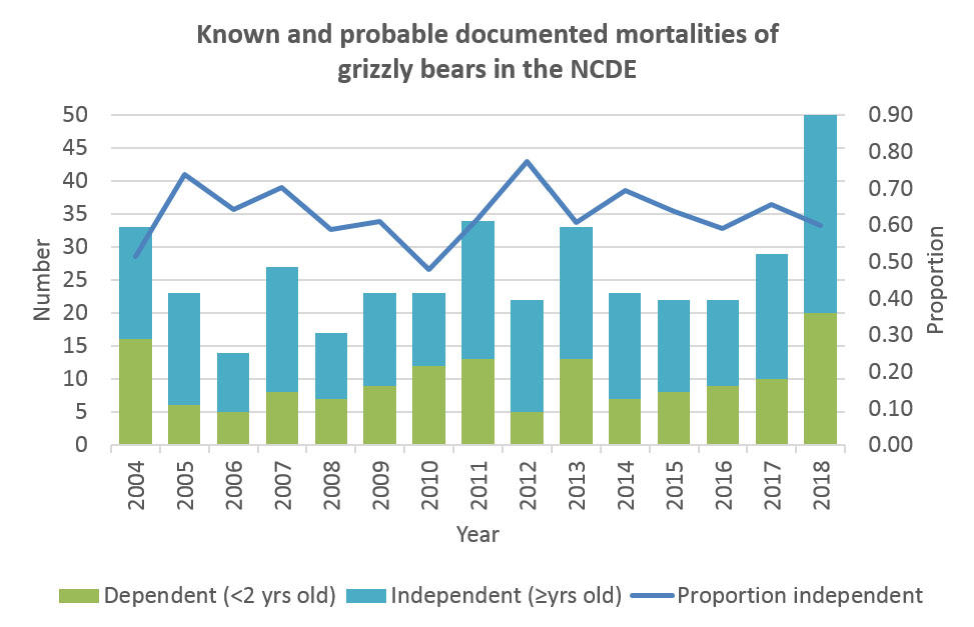Swan Valley Bear News
2018: A RECORD YEAR FOR GRIZZLY DEATHS
By Rob Rich
December 9, 2018
If record highs for human-caused bear mortalities are set, they typically happen late in the fall, when the onset of winter coincides with voracious appetites. This is the time, which scientists call hyperphagia, when bears consume over 15,000 calories per day so that they can go into hibernation with the nourishment needed to survive until spring.
But this year, by the first week of August, 27 grizzlies were killed in the Northern Continental Divide Ecosystem (NCDE). That’s more than one bear death per week, and it surpassed the state’s average of 25 with the top conflict months still ahead. Now, as the bears near hibernation, Montana Fish, Wildlife & Parks has reported records were indeed set as 51 grizzlies died in the NCDE. Automobile collisions alone claimed a total of 17, nearly half the tally counted from the entirety of 2004-2017. And in the Swan Valley, four grizzlies died from human causes: one who a hunter mistook for a black bear, two who were euthanized for repeat conflict behavior, and one cub who was hit on the highway.
This graph shows the 14 year trends in the NCDE mortalities, or bears that were removed from the ecosystem by death or relocation. “Probable” mortalities include bears presumed to be fatally hit by automobiles, but whose bodies could not be found. 2018 was a record year of mortalities for both independent and dependent grizzlies. Credit: Montana Fish, Wildlife, and Parks
The NCDE is one of six recovery zones established by the Interagency Grizzly Bear Committee (IGBC), which formed in 1983 to ensure the return of viable grizzly populations in the lower 48 states. Grizzlies have benefited from Endangered Species Act (ESA) protections across the NCDE’s diverse lands, including parts of five national forests, seven national wildlife refuges, Glacier National Park, the Flathead and Blackfeet Indian Reservations, state lands, and private properties. Since NCDE-wide studies began in 2004, scientists estimate that grizzly populations have grown 2.3 percent per year, approaching 1,000 animals today. The US Fish & Wildlife Service proposed delisting NCDE grizzlies this past June, but complications with delisting bears in the Greater Yellowstone Ecosystem have now put that process on hold.
Sub-adult grizzly who had to be removed this past summer after multiple conflicts involving bear attractants.
Recovery of the NCDE’s bears must be weighed against the number of mortalities, and the public’s capacity to live with bears. As bear populations continue to increase, chances are high that conflicts and mortalities will increase as well. Despite the increase of grizzly bear mortalities in 2018, the IGBC recently stated that although numbers did not surpass a threshold to trigger any conservation strategy actions, there is a growing need to advance coexistence education and outreach.
The NCDE’s bears remain isolated from other recovery areas, but that is changing. As populations continue to expand, grizzlies are returning to the grasslands of eastern Montana, and, after long absence, they’re turning up in old haunts like the Bitterroot Valley. As agency bear managers consider removing protections for NCDE grizzlies, it’s important to remember that bear conflicts aren’t going to go away. As more people move into rural areas and bear populations continue to grow or stabilize, there will continue to be a constant need to perform conflict avoidance measures. There is a constant need to be vigilant and proactive, and here are some of the top things that you can do to promote human-bear coexistence in the Swan Valley and beyond. Carry bear pepper spray, and know how to use it.
Protect your human foods, livestock, garbage, and other attractants in the house, or with an electric fence.
Keep pets close while exploring.
Take special precaution when approaching and field dressing harvested animals while hunting.
Drive the speed limit or slower. Stay alert on the road, especially at night.
Tell your friends about #1-5.
Repeat.
If you are need of advice about different methods to contain various bear attractants, please contact Swan Valley Bear Resources for a free consultation at 754-3137.



